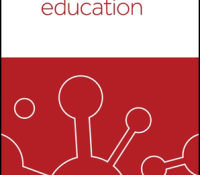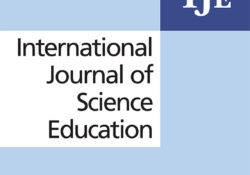
tandfonline.com har udgivet en rapport under søgningen “Teacher Education Mathematics”: Abstract Formulae display:?Mathematical formulae have been encoded as MathML and are displayed in this HTML version using MathJax in order to improve their display. Uncheck the box to turn MathJax off. This feature requires Javascript. Click on a formula to zoom. Abstract While personal performance-approach goals (PAp goals) have already been successfully bifurcated into normative and appearance PAp goals, the same distinction has not yet been applied to performance-approach goal structures (PAp goal structures). The present study therefore aimed to (a) test the factorial two-level structure of PAp goal structures to establish whether a distinction between normative and appearance components is empirically supported, and (b) explore relations to achievement and approach-oriented achievement goals (mastery-approach goals, normative and appearance personal PAp… Continue Reading →
Like this:
Like Loading...
tandfonline.com har udgivet en rapport under søgningen “Teacher Education Mathematics”: Abstract Formulae display:?Mathematical formulae have been encoded as MathML and are displayed in this HTML version using MathJax in order to improve their display. Uncheck the box to turn MathJax off. This feature requires Javascript. Click on a formula to zoom. Abstract It is often assumed that students’ personal achievement goals are most beneficial when they match the goal structures of the classroom, but interaction between achievement goals and goal structures is not well researched. In this study, we aim at providing a nuanced picture of the direct, interaction, and nonlinear effects of achievement goals and goal structures on test performance and autonomous motivation. We used multiple linear regressions, including interaction and quadratic terms, in combination with response surface methodology… Continue Reading →
Like this:
Like Loading...
tandfonline.com har udgivet en rapport under søgningen “Teacher Education Mathematics”: Abstract Formulae display:?Mathematical formulae have been encoded as MathML and are displayed in this HTML version using MathJax in order to improve their display. Uncheck the box to turn MathJax off. This feature requires Javascript. Click on a formula to zoom. Abstract Technological innovation in science provides complementary tools for exploring new teaching strategies within a pedagogical framework that promotes interaction between the teacher and the learner. This work is based on the implementation of a computer application modeling crystallographic material structures, in order to identify and study the different crystalline structures and their characteristics, based on the techniques of three-dimensional modeling covering the OpenGL library and the Euler rotation matrices, and developed by the C # programming language. The… Continue Reading →
Like this:
Like Loading...
tandfonline.com har udgivet en rapport under søgningen “Teacher Education Mathematics”: Abstract Abstract In 2015, using social media, a new generation of South African university students launched the social justice movement #FeesMustFall. The call for social justice, equity and equality has been a burning issue in South Africa’s education system since the dark days of apartheid. In 1976, non-white students revolted against the apartheid government and many lost their lives during the protest. On 15 October 2015, 40 years later, students from all demographics mobilised to launch a protest under the theme #FeesMustFall against institutional racism which did not die with apartheid. The roots of this movement are symptomatic of deep social and economic concerns rooted in the apartheid history of South Africa. Through the use of social media, students mobilised protest… Continue Reading →
Like this:
Like Loading...
tandfonline.com har udgivet en rapport under søgningen “Teacher Education Mathematics”: ABSTRACT ABSTRACT In this study, we explore the issues and challenges involved in supporting students’ learning to discern relevant and critical aspects of determining oxidation states of atoms in complex molecules. We present a detailed case of an interaction between three students and a tutor during a problem-solving class, using the analytical tool of practical epistemology analysis (PEA). The results show that the ability to make relevant distinctions between the different parts of a molecule for solving the problem, even with the guidance of the tutor, seemed to be challenging for students. These shifts were connected to both purposes that were specific for solving the problem at hand, and additional purposes for general learning of the subject matter, in this… Continue Reading →
Like this:
Like Loading...
eric.ed.gov har udgivet: The present study was an exploratory study of the content-specific knowledge structures of three teacher educators (two in math and one in science). Pathfinder, a method for eliciting associative memory networks, was used to describe the knowledge structures of the teacher educators. Pathfinder was also used to determine changes in knowledge structures of students enrolled in a teaching methodology class taught by each educator. Finally, a measure of the correspondence between students’ knowledge structures and those of the teacher educators was correlated with students’ performances in the courses. For two teacher educators, students’ knowledge structures corresponded more closely with that of the teacher educator after the course than before. For one teacher educator, students exhibited little change in knowledge structure correspondence. Also, students who corresponded most to… Continue Reading →
Like this:
Like Loading...
eric.ed.gov har udgivet: For school districts in California, just as one set of revolutionary new content standards is beginning to feel familiar, another deep change is brewing. Districts have now had more than five years to wrestle with how they implement the Common Core State Standards for Mathematics (CCSS-M) (NGA Center & CCSSO, 2010). Many have made large-scale changes in their systems. However, state math assessment scores have remained flat, suggesting that many districts may still be in the early stages of understanding and implementing changes that are necessary to support instruction. This report describes how 10 districts participating in the Math in Common (MiC) initiative have approached implementation of the CCSS-M somewhat differently. To implement their district visions of the CCSS-M, each MiC district’s MiC leadership team developed three… Continue Reading →
Like this:
Like Loading...




